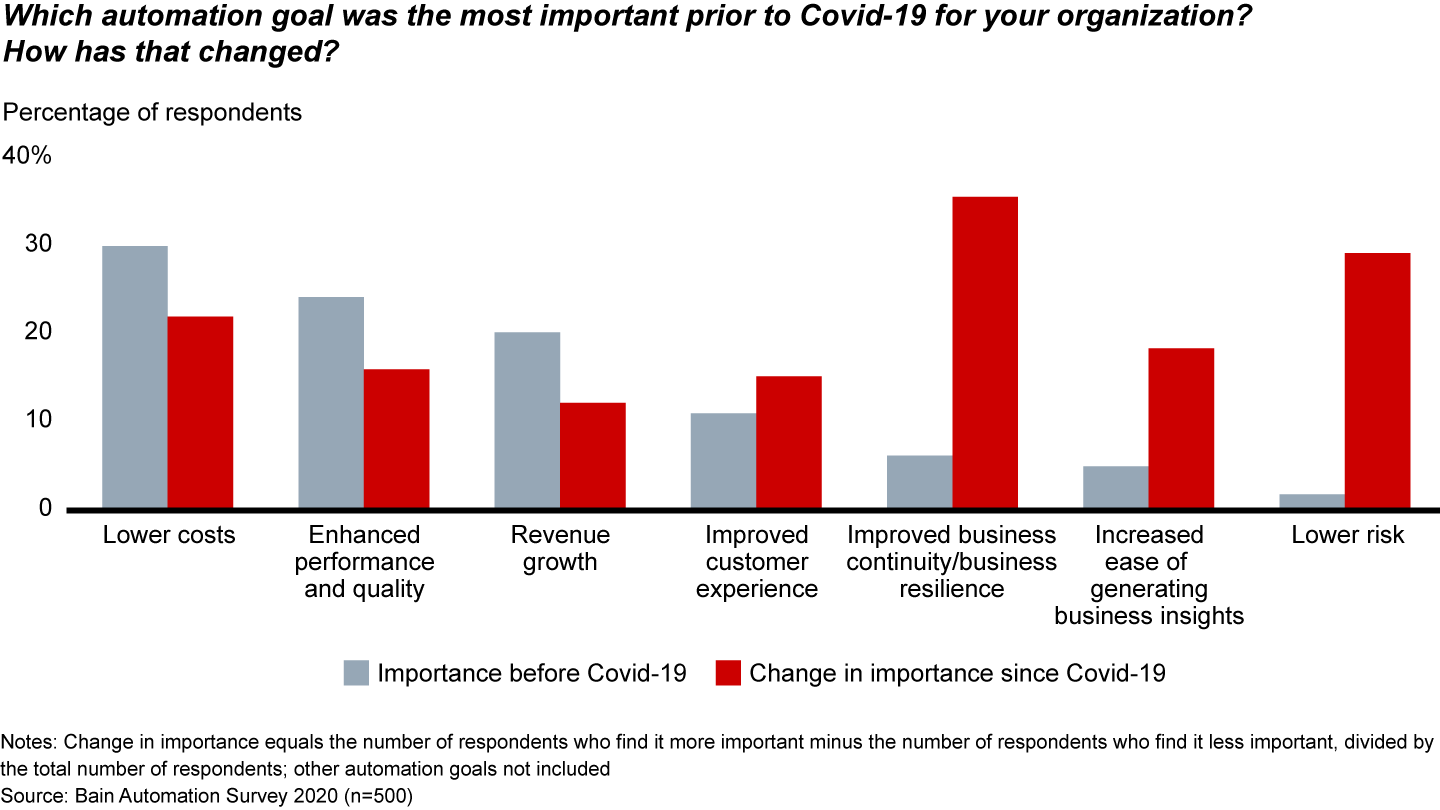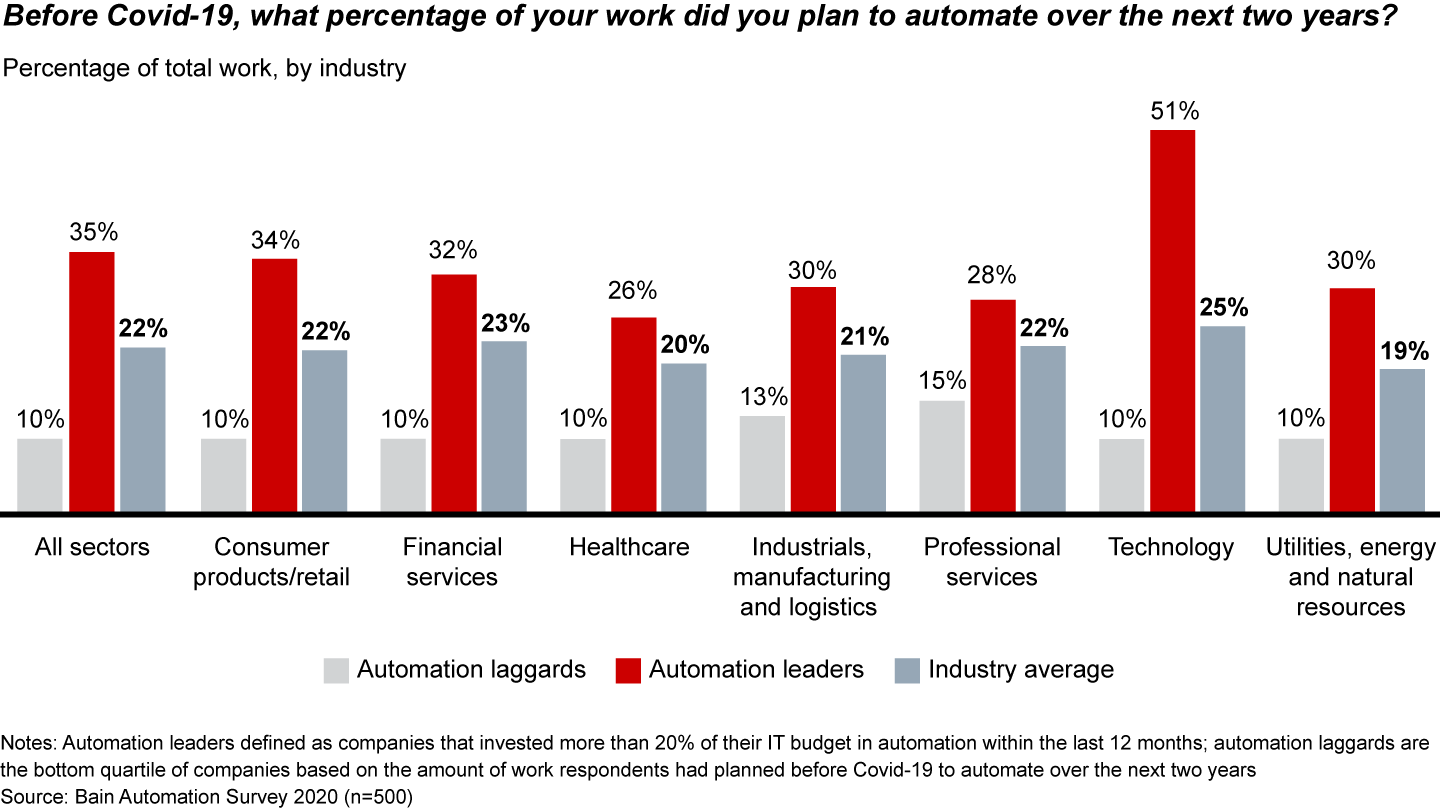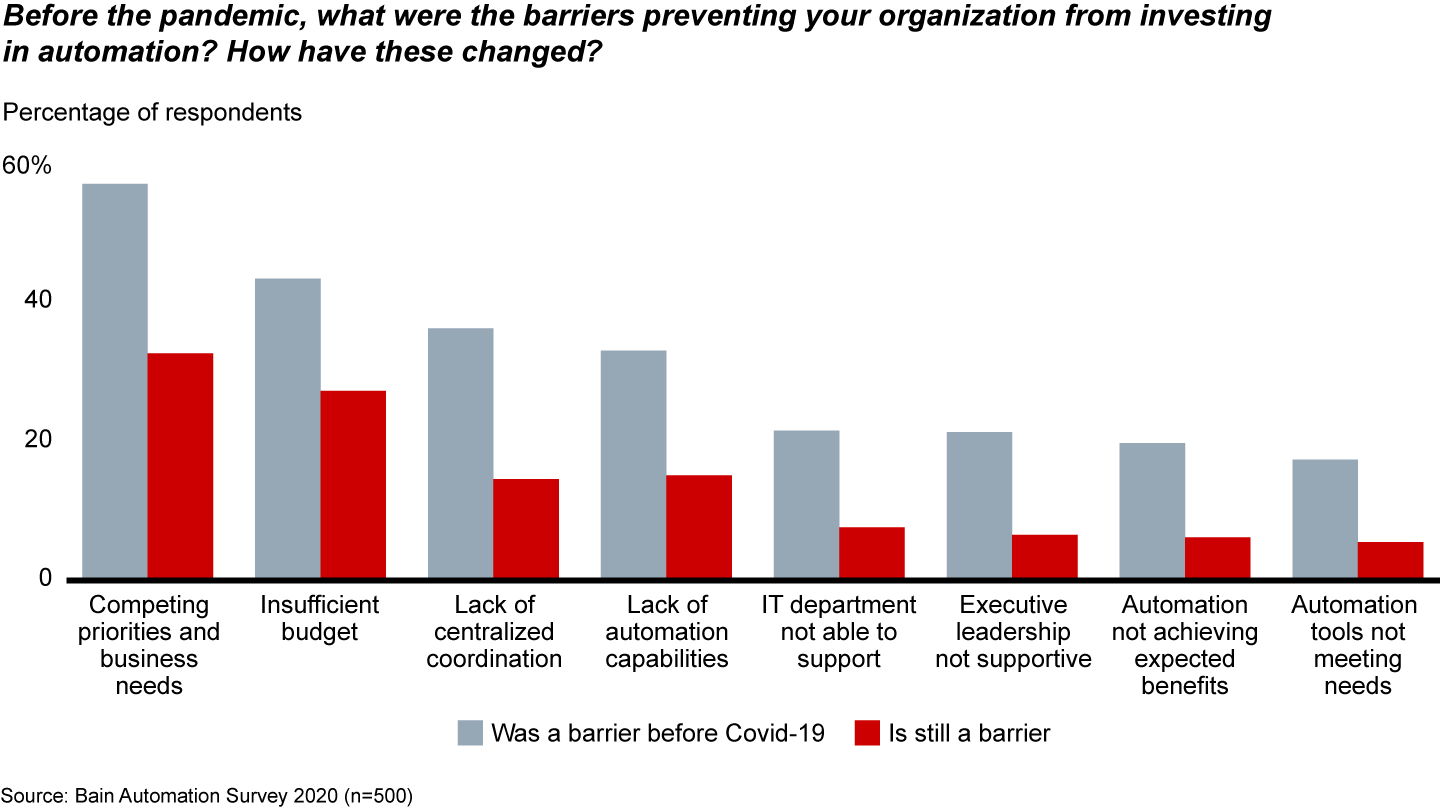Brief

Executive Summary
- Covid-19 has raised the value of automation across industries to strengthen business resilience, reduce risk and generate useful insights.
- Companies that invested more in automation before the pandemic have reported higher revenues than others, with fewer disruptions to productivity or the supply chain, a recent Bain survey finds.
- Leading companies in this field think big about how automation can deliver a competitive edge, rather than one use case at a time.
- They manage automation actively from the start and spend as much, if not more, time on what comes after automation.
In a matter of weeks, automation went from a long-term goal to an urgent, critical need for many executives. The business shock caused by the Covid-19 pandemic has brought home one crucial realization: Automation is no longer primarily about lower costs, but rather about resilience.

Macro Surveillance Platform
For more detail on the business implications of coronavirus from Bain’s Macro Trends Group, log on to the Macro Surveillance Platform. Learn more about the platform >
Companies are increasingly deploying automation to strengthen business resilience, reduce risk and generate useful business insights more easily, according to a recent automation survey conducted by Bain & Company (see Figure 1). Those that invested more in automation before the pandemic have weathered the crisis better than others. They’ve generated higher revenues and experienced fewer disruptions to the supply chain, workforce productivity and demand, our survey found.

Even though most companies in the survey are accelerating their automation initiatives, today’s automation leaders (defined as companies that invested more than 20% of their IT budget in automation within the past 12 months) have a significant head start. Before the coronavirus hit, most leaders across industries planned to automate 30% or more of their manual processes—two to five times more than companies with low automation-adoption rates (see Figure 2).

Over the next year, 38% of the leaders intend to invest significantly more in automation, compared with just 22% of other companies. That’s partly due to the work-at-home exodus, which will endure for many people. Companies in financial services, professional services, telecommunications, media and technology have especially large shares of their workforce who will work remotely even after work sites reopen. The leaders are pressing what they view as a competitive advantage, regardless of when the pandemic abates or how long the downturn lasts. And when the next business shock hits, it will likely put even more stress on companies that haven’t charted a bold automation agenda.
Spread automation across the business
Automation can make a difference across the whole organization. While back-office support and customer service have traditionally had the highest potential, automation can also deliver benefits in R&D, supply chain, operations, and sales and marketing. Many processes lend themselves to automation, from software testing to insurance claims management, fraud detection, cloud infrastructure management, job applicant screening, loan processing and data entry for vaccine clinical trials.
Automation is helping accelerate product development; deliver professional services at a lower cost; resolve customer issues faster, cheaper and more effectively; and increase selling time for field salespeople and channel partners (see Figure 3).
Some of the most compelling developments in recent months reflect how automation has improved the competitive position of companies in the midst of the pandemic.
Covid-19 pushed one large technology company, a leader in deploying automation for years, to apply it in new or less mature areas, such as sales and the order-to-cash process. If all goes as planned, the new automation initiatives could help the company—which generates billions of dollars in annual revenue—save hundreds of millions over the next two years.
The changes include making online selection and ordering easier; automating billing; switching to targeted customer communications that require less oversight; and offering clients more self-service tools for resolving issues. The company has also identified ways to streamline and automate back-office sales support tasks and allow salespeople to spend more time on high-value, revenue-generating activities.
These automation moves have a lot of upside beyond saving money. They’re expected to increase revenue, worker productivity and customer loyalty.
Companies are also using automation to help solve specific problems such as moderating content on social media platforms and in other digital forums. When the pandemic hit, some companies weren’t prepared to transition their contractors to working from home, so their moderation operations were running at reduced capacity. At the same time, traffic spiked on many of these platforms.
In response, some digital forums are partially automating content moderation with artificial intelligence (AI) technologies from developers such as Hive. The San Francisco-based company has added dozens of clients since March, when many stay-at-home orders went into effect around the world. The company now processes more than 1 billion posts a month that previously were reviewed by humans or not at all.
Besides increased efficiency, Hive’s product has made content-moderation operations more effective. A video chat platform that used to field thousands of user complaints weekly about inappropriate content now reports fewer than one incident per week after integrating Hive’s AI models. Another client, French social video-chatting app Yubo, which started using Hive’s services before the pandemic, has been able to handle a 200% increase in the number of livestreams on its platform without needing to hire more moderators.
Another sector, offshore business-process outsourcing, was among the hardest hit by Covid-19, because few business-continuity plans anticipated a pandemic. India-based Tata Consultancy Services has held up better than most and is poised to recover faster, thanks in part to automating critical processes before the crisis. When the pandemic forced the company to shift the vast majority of its employees to working from home, it continued to operate effectively and responded nimbly to urgent customer needs. The company plans to have 75% of its employees permanently work from home by 2025; it believes it can maintain or even improve productivity with a mostly distributed workforce, according to news articles.
Remove the roadblocks
The good news for companies investing more in automation is that historical barriers are coming down in the wake of the pandemic, our survey found (see Figure 4). Across industries, companies report greater support from senior executives, better coordination of automation projects and support from IT departments. These developments could speed up deployment of automation, improve its performance and bring a larger return on investment.

It’s unclear whether the favorable conditions on the ground will change once companies recover from the pandemic. What is clear: Businesses have an opening now to accelerate their automation programs.
However, many say they aren’t ready for it. Only 10% of surveyed companies believe they’re highly prepared to address the personnel and change management challenges that automation will create; 11% say they aren’t prepared at all to respond to those workforce issues.
Our analysis of the survey responses and the characteristics of successful automation programs suggests that three principles underpin a successful automation program.
First, think big. Many companies deploy automation one use case at a time, with projects required to quickly pay for themselves through cost savings or new revenue, often within the first year of deployment. Cautious testing and learning, followed by rapid scaling, works well during stable times. Testing and learning still matters, but the Covid-19 crisis has created a rare opening for executives to think big about what can be automated and the value it could bring. Leading firms are challenging their long-held beliefs about why automation may or may not work in their organization. They’re automating more complex activities than just back-office processes and customer service desks.
ICICI Lombard, a general insurer in India, uses AI-based bots to generate quotes and book policies for corporate customers. It now automates issuance of about 90% of certain policies and products for small businesses, with no manual intervention. Recently it partnered with Microsoft to develop India’s first AI-enabled car inspection feature in its mobile app, to simplify making a repair claim.
In its medical business, ICICI Lombard moved from a traditional core system to more flexible, cloud-based automation. It deploys AI-infused automation to process the cashless claims requested by hospitals. The policy-related information, doctor’s diagnosis and recommended course of action are ingested in the AI algorithm, which decides whether to admit a case. A machine-learning program then decides on the optimal claim amount. This entire initial sanctioning process takes about 90 seconds, compared with up to 4 hours when done manually. The company’s doctors thus get freed up to spend time investigating more complex cases.
Second, manage actively from the start. The barriers to automation are falling, but that doesn’t mean companies can cut corners in planning and executing their automation strategy. Success in automation requires more than great technology. It starts with strong C-level sponsorship, so that automation remains a priority and everyone is held accountable for achieving the company’s ambitious targets.
The most effective change programs engage the key stakeholders, including IT, in early, open and direct communication. The senior team must demonstrate beforehand and in detail how automation will change the experience of employees and customers for the better; otherwise, many employees naturally will resist. Good communication, together with retraining programs, can help people start moving toward new career paths, including those within the same company.
The economic downturn will constrain budgets, so choosing the wrong funding model could stifle adoption. Asking business units to fund their own investments works well when a company’s automation capabilities are mature, demand from the businesses is high, and accountability for the return on investment is essential. Conversely, a centrally funded model might make more sense if a company doesn’t have a proven track record or healthy demand for automation.
MetLife focuses on making the benefits and performance of automation transparent to all employees. It has developed hundreds of demos on robotic process automation (RPA), installed widely accessible dashboards and metrics, and created internal RPA training to help reskill employees affected by the changes or seeking professional development. MetLife also set up a digital automation center of excellence that helps the business units identify use cases that matter to them, then roll out and manage their digital workforce. This approach has enabled broad adoption across geographies and functions such as new business and underwriting, policy administration, claims and finance.
Third, prepare for what comes after automation. Beyond developing, testing, deploying and maintaining the technology, what really matters is achieving the expected business outcomes from the automation. In this respect, it’s similar to outsourcing. Beyond selecting the right partner, negotiating a competitive contract and transitioning the work to the provider, the organization left behind must be sized correctly and fit for purpose, or else the savings from outsourcing won’t materialize.
The risk is even higher for automation because much of the work automated consumes only a fraction of each employee’s time. Companies have to redesign the jobs affected by automation, or they won’t be able to achieve their goals.
Amazon has pledged to spend $700 million over six years to retrain one-third of its US workforce as automation upends the way many employees do their jobs. Hourly workers in fulfillment centers can retrain for IT support roles, such as managing the machines that operate throughout the facilities. Nontechnical corporate workers will have the chance to spend several years retraining as software engineers without going back to college.
What comes next
After the events of this year, many executives see automation as a critical asset that can strengthen their businesses and give them a strategic advantage.
Now comes the hard part. Before the pandemic, nearly half of automation projects failed to deliver the expected savings, according to a 2019 Bain survey. Executives also face the challenge of compassionately treating employees displaced by automation. Amazon’s reskilling program, for instance, mitigates some of the pain of dislocation, and has the added benefit of helping to retain talented employees.
Although the situation on the ground has changed and traditional barriers to automation are crumbling, companies still have their work cut out to turn its promise into reality. It’s well worth the effort, as the rewards could be substantial.

Coronavirus
The global Covid-19 pandemic has extracted a terrible human toll and spurred sweeping changes in the world economy. Across industries, executives have begun reassessing their strategies and repositioning their companies to thrive now and in the world beyond coronavirus.


